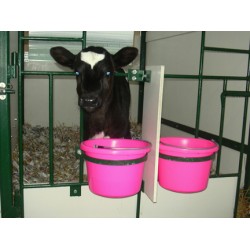Pasteurising milk and colostrum for calf feeding is becoming more popular in the UK. Aly Balsom looks at how it can be done and the potential benefits.
Pasteurisation can have an important role in youngstock rearing by promoting health and consistency of feeding in calves pre-weaning.
Whether talking about colostrum or whole “waste” milk, pasteurisation can help reduce calf disease challenge by killing bacterial pathogens such as E coli, salmonella and Mycoplasma bovis.
Pasteurisation is the process of heating milk or colostrum at a target temperature for a given time, followed by a period of cooling, with the aim to reduce bacterial loading.
Vet Tim Potter of Westpoint Vet Group says it was originally introduced as a way to manage waste milk. This milk is likely to be from high SCC or mastitis cows or contain antibiotic residues and as such could potentially pose a health risk.
“It’s not an ideal product, so by pasteurising it is a way of making the best of a compromised situation. It’s all about limiting health risk and keeping it (the milk) as consistent as possible,” he explains.
Dr Potter says generally farmers that pasteurise waste milk see reduced levels of scours and overall improved health during the milk feeding period.
“Pasteurisation needs to be part of a good feeding regime which promotes consistency and cleanliness. Milk should be fed at consistent volumes and the same time and temperature every day,” he says.
Many farmers also adopt milk pasteurisation as part of a Johne’s control strategy. Research surrounding the effectiveness of pasteurisation on killing Johne’s in milk and colostrum is variable. However, there is suggestion it could help in the fight against it (see box).
Done correctly, pasteurising colostrum can promote better absorption of immunoglobulins IgG (see box). However, it can also denature essential IgGs so it is crucial it is heated at the correct temperature and for the correct time.
Because pasteurisation does not sterilise milk or colostrum, it is also important to keep the raw product as clean as possible. Store in a sealed reject milk vessel, away from direct sunlight and pasteurise as soon as possible.
Case study: Stuart Heath, Red Earth Farm, Staffordshire
Stuart Heath believes milk pasteurisation has been one of the main reasons he has witnessed improvements in calf health and value over the last two years.
All of the 500-cow flying herd at Red Earth Farm is put to British Blue, with all calves sold at four to six weeks old. As a result, producing a quality calf that will attract repeat buyers is crucial.
Prior to the introduction of a milk pasteuriser, Mr Heath admits calves were not doing as well as they could, with some being lost to scours.
“Before, we used to pool waste milk in a 60gal vessel and carry it to the calves in buckets. It used to sit there and cool down so it was difficult to feed at a consistent temperature,” Mr Heath explains.
Waste milk is now pumped from the parlour at the end of milking to the calf shed where the 150-litre batch pasteuriser is kept. The morning milk, for example will then be pasteurised for feeding in the afternoon with the milk then warmed by the machine to 38C prior to feeding.
“It means we’ve got a dedicated set feeding time and milk is there at the right temperature so no one minds doing it,” says Mr Heath.
“It’s made a huge difference. We’ve definitely seen a reduction in scours and a lot fewer serious cases because the milk is more consistent. We’ve also seen an increase in the number of quality calves produced and that’s been reflected in better prices.”
Pasteurisation benefits
Research carried out by Sandra Godden from the University of Minnesota has shown:
- Pasteurising colostrum can promote better absorption of immunoglobulins (IgG) leading to improved calf health.
- Heat treating colostrum at 60C for 60min does not negatively affect IgG, can reduce or eliminate bugs such as E coli, salmonella and Mycoplasma bovis, and significantly reduce total coliform counts.
- Feeding pasteurised milk led to a significant reduction in the proportion of calves treated or scouring.
- Batch pasteurising milk for 30min at 63C could kill Johne’s-causing bugs.
- Calves fed pasteurised waste milk instead of milk replacer were found not to be at increased risk of Johne’s infection.
Different pasteurisation options
(1) Batch pasteurisers
- Most commonly used on dairy units.Typically made up of a control box, container (for milk or colostrum), an agitator and a heated water jacket surrounding the container.
- Capacity: 30-550 litres.
- Cost: About £4,000-10,000.
There are also smaller, specifically designed batch pasteurisers on the market that are designed purely to pasteurise bags of colostrum.
(2) Continuous flow pasteurisers or high temperature, short-time pasteurisers (HTST)
- More suited to larger operations. Made up of a plate or tube heat exchanger in which hot water is used to heat milk. The continuous flow of milk is rapidly heated and cooled.
- Not suitable for colostrum as the high temperature will denature the immunoglobulins.
- Capacity: From 100 litres/hr upwards.
- Cost: Starts from about £10,000.
Source: G Shephard Animal Health. Features a DueCinox batch pasteuriser




